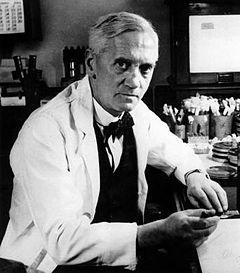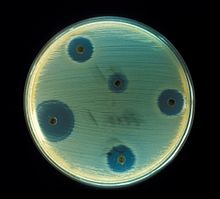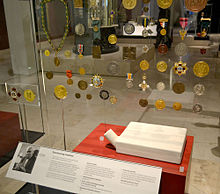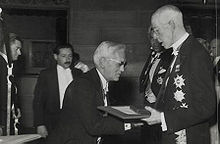
Alexander Fleming
Background Information
Arranging a Wikipedia selection for schools in the developing world without internet was an initiative by SOS Children. Click here to find out about child sponsorship.
Sir Alexander Fleming, FRSE, FRS, FRCS(Eng) (6 August 1881 – 11 March 1955) was a Scottish biologist, pharmacologist and botanist. He wrote many articles on bacteriology, immunology, and chemotherapy. His best-known discoveries are the enzyme lysozyme in 1923 and the antibiotic substance penicillin from the mould Penicillium notatum in 1928, for which he shared the Nobel Prize in Physiology or Medicine in 1945 with Howard Florey and Ernst Boris Chain.
In 1999, Time magazine named Fleming one of the 100 Most Important People of the 20th Century, stating:
It was a discovery that would change the course of history. The active ingredient in that mould, which Fleming named penicillin, turned out to be an infection-fighting agent of enormous potency. When it was finally recognized for what it was, the most efficacious life-saving drug in the world, penicillin would alter forever the treatment of bacterial infections. By the middle of the century, Fleming's discovery had spawned a huge pharmaceutical industry, churning out synthetic penicillins that would conquer some of mankind's most ancient scourges, including syphilis, gangrene and tuberculosis.
Biography
Early life
Fleming was born on 6 August 1881 at Lochfield, a farm near Darvel, in Ayrshire, Scotland. He was the third of the four children of farmer Hugh Fleming (1816–1888) from his second marriage to Grace Stirling Morton (1848–1928), the daughter of a neighbouring farmer. Hugh Fleming had four surviving children from his first marriage. He was 59 at the time of his second marriage, and died when Alexander (known as Alec) was seven.
Fleming went to Loudoun Moor School and Darvel School, and earned a two-year scholarship to Kilmarnock Academy before moving to London, where he attended the Royal Polytechnic Institution. After working in a shipping office for four years, the twenty-year-old Fleming inherited some money from an uncle, John Fleming. His elder brother, Tom, was already a physician and suggested to his younger sibling that he follow the same career, and so in 1903, the younger Alexander enrolled at St Mary's Hospital Medical School in Paddington. He qualified MBBS from the school with distinction in 1906.
Fleming had been a private in the London Scottish Regiment of the Volunteer Force since 1900, and had been a member of the rifle club at the medical school. The captain of the club, wishing to retain Fleming in the team suggested that he join the research department at St Mary's, where he became assistant bacteriologist to Sir Almroth Wright, a pioneer in vaccine therapy and immunology. He gained a BSc with Gold Medal in 1908, and became a lecturer at St Mary's until 1914. On 23 December 1915, Fleming married a trained nurse, Sarah Marion McElroy of Killala, County Mayo, Ireland.
Fleming served throughout World War I as a captain in the Royal Army Medical Corps, and was Mentioned in Dispatches. He and many of his colleagues worked in battlefield hospitals at the Western Front in France. In 1918 he returned to St Mary's Hospital, where he was elected Professor of Bacteriology of the University of London in 1928.
Research
Work before penicillin
Following World War I, Fleming actively searched for anti-bacterial agents, having witnessed the death of many soldiers from sepsis resulting from infected wounds. Antiseptics killed the patients' immunological defences more effectively than they killed the invading bacteria. In an article he submitted for the medical journal The Lancet during World War I, Fleming described an ingenious experiment, which he was able to conduct as a result of his own glass blowing skills, in which he explained why antiseptics were killing more soldiers than infection itself during World War I. Antiseptics worked well on the surface, but deep wounds tended to shelter anaerobic bacteria from the antiseptic agent, and antiseptics seemed to remove beneficial agents produced that protected the patients in these cases at least as well as they removed bacteria, and did nothing to remove the bacteria that were out of reach. Sir Almroth Wright strongly supported Fleming's findings, but despite this, most army physicians over the course of the war continued to use antiseptics even in cases where this worsened the condition of the patients.
Accidental discovery
"When I woke up just after dawn on September 28, 1928, I certainly didn't plan to revolutionise all medicine by discovering the world's first antibiotic, or bacteria killer," Fleming would later say, "But I suppose that was exactly what I did."
By 1927, Fleming was investigating the properties of staphylococci. He was already well-known from his earlier work, and had developed a reputation as a brilliant researcher, but his laboratory was often untidy. On 3 September 1928, Fleming returned to his laboratory having spent August on holiday with his family. Before leaving, he had stacked all his cultures of staphylococci on a bench in a corner of his laboratory. On returning, Fleming noticed that one culture was contaminated with a fungus, and that the colonies of staphylococci that had immediately surrounded it had been destroyed, whereas other colonies farther away were normal. Fleming showed the contaminated culture to his former assistant Merlin Price, who reminded him, "That's how you discovered lysozyme." Fleming grew the mould in a pure culture and found that it produced a substance that killed a number of disease-causing bacteria. He identified the mould as being from the Penicillium genus, and, after some months of calling it "mould juice", named the substance it released penicillin on 7 March 1929.
He investigated its positive anti-bacterial effect on many organisms, and noticed that it affected bacteria such as staphylococci and many other Gram-positive pathogens that cause scarlet fever, pneumonia, meningitis and diphtheria, but not typhoid fever or paratyphoid fever, which are caused by Gram-negative bacteria, for which he was seeking a cure at the time. It also affected Neisseria gonorrhoeae, which causes gonorrhoea although this bacterium is Gram-negative.
Fleming published his discovery in 1929, in the British Journal of Experimental Pathology, but little attention was paid to his article. Fleming continued his investigations, but found that cultivating penicillium was quite difficult, and that after having grown the mould, it was even more difficult to isolate the antibiotic agent. Fleming's impression was that because of the problem of producing it in quantity, and because its action appeared to be rather slow, penicillin would not be important in treating infection. Fleming also became convinced that penicillin would not last long enough in the human body (in vivo) to kill bacteria effectively. Many clinical tests were inconclusive, probably because it had been used as a surface antiseptic. In the 1930s, Fleming’s trials occasionally showed more promise, and he continued, until 1940, to try to interest a chemist skilled enough to further refine usable penicillin. Fleming finally abandoned penicillin, and not long after he did, Howard Florey and Ernst Boris Chain at the Radcliffe Infirmary in Oxford took up researching and mass-producing it, with funds from the U.S. and British governments. They started mass production after the bombing of Pearl Harbour. When D-Day arrived, they had made enough penicillin to treat all the wounded Allied forces.
Purification and stabilisation
In Oxford, Ernst Boris Chain and Edward Abraham worked out how to isolate and concentrate penicillin. Abraham was the first to propose the correct structure of penicillin. Shortly after the team published its first results in 1940, Fleming telephoned Howard Florey, Chain's head of department, to say that he would be visiting within the next few days. When Chain heard that he was coming, he remarked "Good God! I thought he was dead."
Norman Heatley suggested transferring the active ingredient of penicillin back into water by changing its acidity. This produced enough of the drug to begin testing on animals. There were many more people involved in the Oxford team, and at one point the entire Dunn School was involved in its production.
After the team had developed a method of purifying penicillin to an effective first stable form in 1940, several clinical trials ensued, and their amazing success inspired the team to develop methods for mass production and mass distribution in 1945.
Fleming was modest about his part in the development of penicillin, describing his fame as the "Fleming Myth" and he praised Florey and Chain for transforming the laboratory curiosity into a practical drug. Fleming was the first to discover the properties of the active substance, giving him the privilege of naming it: penicillin. He also kept, grew and distributed the original mould for twelve years, and continued until 1940 to try to get help from any chemist who had enough skill to make penicillin. But Sir Henry Harris said in 1998: "Without Fleming, no Chain; without Chain, no Florey; without Florey, no Heatley; without Heatley, no penicillin."
Antibiotics
Fleming's accidental discovery and isolation of penicillin in September 1928 marks the start of modern antibiotics. Before that, several scientists had published or pointed out that mould or penicillium sp. were able to inhibit bacterial growth, and even to cure bacterial infections in animal ( Ernest Duchesne in 1897 in his thesis "Contribution to the study of vital competition in micro-organisms: antagonism between moulds and microbes", or also Clodomiro Picado Twight whose work at Institut Pasteur in 1923 on the inhibiting action of fungi of the "Penicillin sp" genre in the growth of staphylococci drew little interest from the direction of the Institut at the time). Fleming was the first to push these studies further by isolating the penicillin, and by being motivated enough to promote his discovery at a larger scale. Fleming also discovered very early that bacteria developed antibiotic resistance whenever too little penicillin was used or when it was used for too short a period. Almroth Wright had predicted antibiotic resistance even before it was noticed during experiments. Fleming cautioned about the use of penicillin in his many speeches around the world. He cautioned not to use penicillin unless there was a properly diagnosed reason for it to be used, and that if it were used, never to use too little, or for too short a period, since these are the circumstances under which bacterial resistance to antibiotics develops.
Personal life
The popular story of Winston Churchill's father paying for Fleming's education after Fleming's father saved young Winston from death is false. According to the biography, Penicillin Man: Alexander Fleming and the Antibiotic Revolution by Kevin Brown, Alexander Fleming, in a letter to his friend and colleague Andre Gratia, described this as "A wondrous fable." Nor did he save Winston Churchill himself during World War II. Churchill was saved by Lord Moran, using sulphonamides, since he had no experience with penicillin, when Churchill fell ill in Carthage in Tunisia in 1943. The Daily Telegraph and the Morning Post on 21 December 1943 wrote that he had been saved by penicillin. He was saved by the new sulphonamide drug, Sulphapyridine, known at the time under the research code M&B 693, discovered and produced by May & Baker Ltd, Dagenham, Essex – a subsidiary of the French group Rhône-Poulenc. In a subsequent radio broadcast, Churchill referred to the new drug as "This admirable M&B." It is highly probable that the correct information about the sulphonamide did not reach the newspapers because, since the original sulphonamide antibacterial, Prontosil, had been a discovery by the German laboratory Bayer, and as Britain was at war with Germany at the time, it was thought better to raise British morale by associating Churchill's cure with the British discovery, penicillin.
Fleming's first wife, Sarah, died in 1949. Their only child, Robert Fleming, became a general medical practitioner. After Sarah's death, Fleming married Dr. Amalia Koutsouri-Vourekas, a Greek colleague at St. Mary's, on 9 April 1953; she died in 1986.
Death
In 1955, Fleming died at his home in London of a heart attack. He was buried at St Paul's Cathedral.
Honours, awards and achievements

His discovery of penicillin had changed the world of modern medicine by introducing the age of useful antibiotics; penicillin has saved, and is still saving, millions of people around the world.
The laboratory at St Mary's Hospital where Fleming discovered penicillin is home to the Fleming Museum, a popular London attraction. His alma mater, St Mary's Hospital Medical School, merged with Imperial College London in 1988. The Sir Alexander Fleming Building on the South Kensington campus was opened in 1998 and is now one of the main preclinical teaching sites of the Imperial College School of Medicine.
His other alma mater, the Royal Polytechnic Institution (now the University of Westminster) has named one of its student halls of residence Alexander Fleming House, which is near to Old Street.
- Fleming, Florey and Chain jointly received the Nobel Prize in Medicine in 1945. According to the rules of the Nobel committee a maximum of three people may share the prize. Fleming's Nobel Prize medal was acquired by the National Museums of Scotland in 1989 and is on display after the museum re-opened in 2011.
- Fleming was a member of the Pontifical Academy of Sciences.
- Fleming was awarded the Hunterian Professorship by the Royal College of Surgeons of England.
- Fleming was knighted, as a Knight Bachelor, by king George VI in 1944.
- In 1999, Time Magazine named Fleming one of the 100 Most Important People of the 20th century.
- When 2000 was approaching, at least three large Swedish magazines ranked penicillin as the most important discovery of the millennium.
- In 2002, Fleming was named in the BBC's list of the 100 Greatest Britons following a nationwide vote.
- A statue of Alexander Fleming stands outside the main bullring in Madrid, Plaza de Toros de Las Ventas. It was erected by subscription from grateful matadors, as penicillin greatly reduced the number of deaths in the bullring.
- Flemingovo náměstí is a square named after Fleming in the university area of the Dejvice community in Prague.
- In mid-2009, Fleming was commemorated on a new series of banknotes issued by the Clydesdale Bank; his image appears on the new issue of £5 notes.
- 91006 Fleming, an asteroid in the Asteroid Belt, is named for Fleming.






